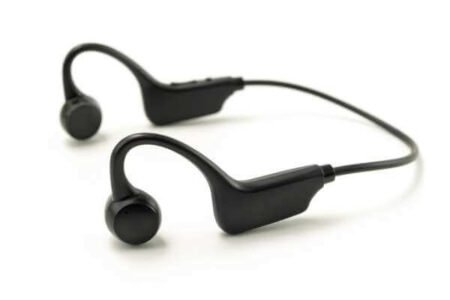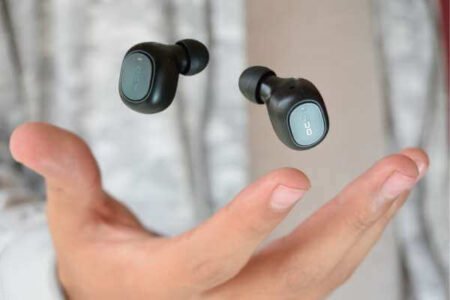Bone conduction technology and earbuds are two popular options for listening to audio without obstructing the ear canal. Bone conduction headphones work by transmitting sound waves through the bones of the skull, directly to the inner ear, bypassing the eardrums. This allows the listener to hear ambient sounds while also enjoying music or other audio content. On the other hand, earbuds are small, compact headphones that fit directly into the ear canal, providing a more traditional audio experience by blocking out external sounds. While bone conduction technology is beneficial for individuals with hearing impairments or those who need to remain aware of their surroundings, earbuds are favored for their immersive sound experience and noise isolation. In this article, we will explore Bone Conduction vs Earbuds, including their respective benefits and drawbacks, to help you make the best decision on which one is better for you.
What are the potential health issues associated with bone-conduction headphones and earbuds?
Bone Conduction Headphones

- Prolonged contact with the skin around the temples or jawbone by bone conduction transducers may cause discomfort or skin irritation.
- Incorrect or extended use of bone conduction headphones could potentially lead to misalignment of the jaw, causing temporomandibular joint (TMJ) issues in some cases.
- Bone conduction headphones may inadvertently leak sound to others nearby, especially at higher volumes, causing disturbances or annoyances.
Earbuds

- Listening to music or audio at high volumes through earbuds can lead to noise-induced hearing loss over time.
- Inserting earbuds into the ear canal can introduce bacteria and elevate the risk of ear infections, particularly when the earbuds are shared or not maintained in a clean condition.
- Prolonged use of earbuds, especially if they are not properly fitted or have a hard or uncomfortable design, can lead to ear canal discomfort or soreness.
- The noise isolation provided by earbuds can lead to reduced awareness of the surrounding environment, potentially causing safety issues, especially during outdoor activities.
- Consistently listening to loud sounds through earbuds can contribute to the development of tinnitus, a persistent ringing or buzzing sensation in the ears.
Bone Conduction vs Earbuds
Understanding the Technology:
Earbuds: Earbuds are small, in-ear devices that deliver sound directly into the ear canal. They block external noise and immerse the listener in the audio experience.
Bone Conduction Headphones: Bone conduction headphones, on the other hand, rest outside the ear and transmit sound through vibrations directly to the bones of the skull. This allows users to hear ambient sounds while still enjoying audio content.
Safety Considerations
Hearing Health
Earbuds: Directly delivering sound into the ear canal can potentially lead to hearing damage, especially if used at high volumes for extended periods.
Bone Conduction Headphones: By not obstructing the ear canal, bone conduction headphones offer a potentially safer alternative as they allow users to enjoy audio without the risk of direct auditory damage.
Awareness of Surroundings
Earbuds: The snug fit of earbuds provides noise isolation, which can be a safety concern in certain situations, such as while walking or cycling in traffic.
Bone Conduction Headphones: Since bone conduction headphones keep the ears open, users remain more aware of their surroundings, making them a safer option for outdoor activities.
Comfort and Hygiene
Earbuds: Prolonged use of earbuds may lead to discomfort or ear fatigue. Additionally, earbuds can trap moisture in the ear canal, potentially leading to ear infections.
Bone Conduction Headphones: Placed outside the ears, bone conduction headphones are often more comfortable for extended wear, and they don’t pose the same risk of trapping moisture in the ear canal.
Personal Preference
Earbuds: Some users prefer the immersive sound experience provided by earbuds, despite the potential safety concerns.
Bone Conduction Headphones: Others appreciate the open-ear design of bone conduction headphones, valuing the combination of audio enjoyment and environmental awareness.
Activity-Centric Performance: Bone Conduction vs Earbuds
When comparing bone-conduction headphones and earbuds for various activities, it’s evident that they serve distinct purposes and are most suitable for specific endeavors.
For physical activities like running and cycling, bone-conduction headphones are ideal as they allow the user to remain aware of their surroundings. This improves safety by not blocking the ear canal. In contrast, earbuds can isolate the user from the environment due to their noise-cancelling feature.
In professional settings where staying connected and being aware of ambient sounds is important, bone conduction technology is preferred. It allows for clear communication while keeping the ears open. On the other hand, earbuds may hinder communication by blocking external noises.
Music enthusiasts favor earbuds for their superior sound quality and immersive audio experiences when it comes to music and entertainment. However, bone conduction headphones offer a unique listening experience by allowing users to enjoy music without covering their ears.
Conclusion
Comparisons are underway between bone-conduction headphones and earbuds to determine their respective safety levels. It is clear that bone conduction technology offers safety advantages by lowering the risk of direct damage to the eardrums from loud sounds.
Bone conduction headphones have a special way of transmitting sound, making them suitable for activities requiring awareness of surroundings and communication while still delivering good audio quality. However, the choice between bone conduction headphones and traditional earbuds should be based on personal preferences and specific needs, to ensure a balanced auditory experience that emphasizes safety and enjoyment.



